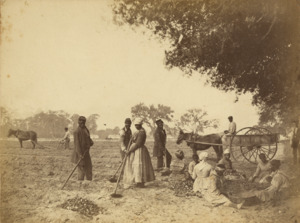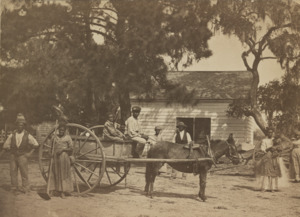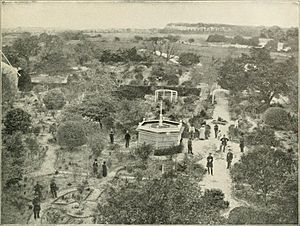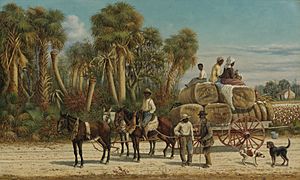Edisto Island during the American Civil War facts for kids
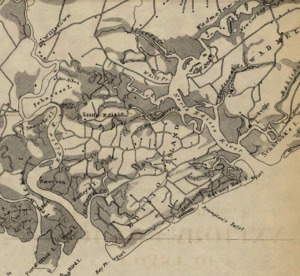
Edisto Island in South Carolina was an important place during the American Civil War (1861–1865). It saw several small battles. For a time, it was also home to many escaped African-American slaves. They created their own communities there.
In November 1861, most plantation owners left the island. By December, escaped slaves began building refugee camps. In January 1862, armed African Americans from the island clashed with Confederate soldiers. A Confederate attack later killed some unarmed African Americans.
Union forces arrived in February to protect the growing community. They also wanted to use the island as a base to attack Charleston, which was 25 miles away. As Union troops took over, there were more small fights. But the Confederates eventually left.
In June, most Union troops left Edisto Island for a big battle. This battle was called the Battle of Secessionville. In July, the remaining troops also left. The community of escaped slaves moved to St. Helena Island. For the rest of the war, only a few people lived and farmed on Edisto Island. Near the end of the war, it again became a place for communities of freed slaves.
Contents
Edisto Island: Early Days of the War
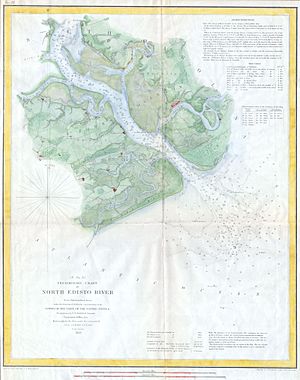
After a battle in late 1861, Confederate General Nathan George Evans was put in charge of South Carolina and Georgia. Protecting Charleston was a big part of his job. Edisto Island was key to the Union's plans to attack Charleston. The North Edisto River offered a safe harbor for large ships. From there, Union forces could move closer to the Charleston and Savannah Railroad.
Confederate General P. G. T. Beauregard led Charleston's defenses at the start of the war. He worked with local leaders to make the island stronger. However, General Robert E. Lee later took command of coastal defenses. Lee thought the sea islands were too hard to defend. He decided to set up a defense line further inland.
In November 1861, Union forces landed along the coast, especially at Port Royal. Many white plantation owners then fled inland. Some, including those on Edisto Island, burned their cotton. They did this to stop the Union from getting it.
In December 1861, Union General Thomas W. Sherman took control of Otter Island and other areas. Naval Commander Samuel F. Du Pont sent Commander Percival Drayton to help. Drayton met many slaves who gave him information about Confederate actions. Drayton learned that rebels had burned slave houses. He helped set up a community for over 100 former slaves on Otter Island.
These "contrabands" (escaped slaves) helped themselves too. They helped get supplies. Union leaders knew the rebels were a threat to these communities. Drayton explored the Edisto River. He found empty Confederate forts and guns. He also found Confederates burning cotton houses. When he returned to his ship, 150 African Americans had gathered there. Drayton sent them to Edisto Island. They set up a camp in a wooded area, protected by a marsh.
By December 1861, 700 to 900 African Americans were on Botany Bay Island, part of Edisto Island. But Confederates were still a threat. Union Lieutenant Daniel Ammen reported that the community had grown to 1,200 people by January 1862. He said Union forces needed to occupy Edisto Island to protect them. Ammen also suggested hiring the contrabands to collect cotton.
Escaped Slaves Fight Back
On January 20, 1862, a group of African Americans got weapons. They fired at Confederate guards near Watt's Cut. General Evans ordered Colonel Peter F. Stevens to stop the uprising. Stevens led 120 infantry and 65 cavalry soldiers.
On January 22, Stevens arrived at Edisto. He learned that a group of African Americans had attacked a local plantation. He searched for them. Stevens captured some African Americans. About four former slaves were killed or wounded, including women and elderly people. About 14 were captured, also including women and elderly. However, many people in the camp had been warned and fled before the Confederates arrived.
On January 23, Union Navy Lieutenant Alexander C. Rhind reported on the attack. He had gathered 100 to 150 refugees. He ordered his ship to fire on houses where rebels were reported to be. More escaped slaves kept arriving. By February 3, an agent estimated there were 2,300 people in the camps. By February 10, another estimated 8,000 to 10,000. There was a growing risk of hunger and sickness.
Union Soldiers Arrive
Union General Thomas Sherman sent soldiers to North Edisto Island on February 12. These soldiers, from the 47th New York Volunteer Infantry, would protect the community. They would also set up a camp. Their leader, Colonel Henry Moore, made his headquarters at Point of Pines. This became the main base for all Union troops on the island.
By mid-March, Union forces had moved to Little Edisto Island. General Evans was told the Union might cross to the mainland. He ordered Colonel P. F. Stevens to attack the Union soldiers. On March 29, Stevens' Confederate troops pushed Union forces off Little Edisto Island. They captured 21 prisoners. The Union soldiers retreated to their cannons on Edisto Island. The Confederate attack stopped. Two Union soldiers died, and several were wounded on both sides.
The Union Navy was also very active. On March 18, a Confederate cannon battery fired on a Union Navy ship. On April 18, the Crusader was attacked by Confederate cavalry. Three Union sailors were wounded. The next morning, 60 Union soldiers fought the Confederates for about 15 minutes. The Confederates then retreated. No other Union soldiers were hurt. On April 29, Union gunboats attacked Confederate forts near Pineberry.
Edisto Island Becomes a Base
Union forces kept sending more troops. By March 31, 1862, General David Hunter reported 1,400 troops on Edisto Island. Hunter had taken over command of the area. He planned to attack Charleston.
Confederate General John C. Pemberton had left the mouth of the Stono River. This allowed Union forces to land on James Island, South Carolina. Hunter's plan was to send one group of soldiers to Sol Legare Island, South Carolina. Another group would go from Edisto Island to Johns Island, then to James Island.
By May 1862, many different Union army units were on Edisto Island. These included cavalry, infantry, and artillery. Most of these troops left the island on June 2. They were part of Hunter's plan to attack Charleston. However, this plan failed. The Confederates won a victory at the Battle of Secessionville on nearby James Island on June 16.
Union Troops Leave
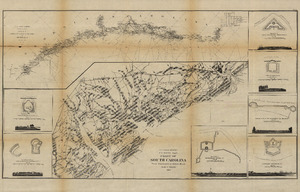
In the summer of 1862, Union troops protecting coastal communities began to leave. They were sent to help Union General George B. McClellan in Virginia. Hunter pulled the rest of the soldiers from Edisto Island on July 11.
The last troops to leave were from the 55th Pennsylvania and some Massachusetts soldiers. They also took two cannons. Because of this, the person in charge of the escaped slaves, Francis E. Barnard, organized the 1,600 former slaves. They took their animals and belongings and moved by boat to St. Helena village. They stayed there for the rest of the war. The farms and crops on Edisto Island were left empty. Barnard later died from malaria.
Only a very small number of escaped slaves stayed on Edisto Island. The Union Navy kept a blockade station off North Edisto Island. Robert Smalls, a recently escaped slave, helped move troops from the island on his ship, the Planter. Smalls returned to the island in 1865 with General Rufus Saxton to inspect the area.
Life on Edisto Island After the War
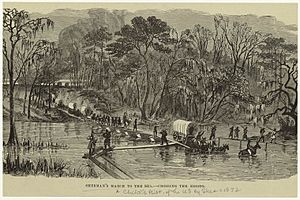

On April 9, 1863, two escaped slaves came to Captain J. C. Dutch on his ship, the Kingfisher. They told him about ten Confederate scouts from the island. These scouts were watching Union ships going to and from Charleston. Guided by the former slave, Union sailors landed and captured almost all the Confederates. In May 1863, Dutch sent soldiers to raid corn from several plantations on the island. This corn helped feed the escaped slaves in nearby camps.
In December 1864, General William Tecumseh Sherman captured Savannah during his "March to the Sea." Many slaves had fled and followed Sherman's army. General Rufus Saxton suggested Edisto Island as a good place for new communities. This was because it had hosted communities before and was mostly free of rebels.
At the end of the war, Saxton became the Inspector of Settlements and Plantations. Under his guidance, many former refugees returned to Edisto. In 1865, the Freedmen's Bureau helped manage the community on Edisto. Old plantations, like the William Seabrook House, were used as camps for freed slaves. Teachers from the Freedmen's Bureau lived and taught at places like Crawford's Plantation House.
Images for kids


